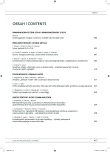Hemangioblastoma of the Cauda Equina – a Case Report
Authors:
D. Bludovský 1; V. Runt 1; M. Choc 1; M. Michal 2; J. Kastner 3
Authors‘ workplace:
LF UK a FN Plzeň
Neurochirurgické oddělení
1; LF UK a FN Plzeň
Šiklův patologicko-anatomický ústav
2; LF UK a FN Plzeň
Klinika zobrazovacích metod
3
Published in:
Cesk Slov Neurol N 2010; 73/106(5): 552-554
Category:
Case Report
Overview
Hemangioblastomas are rare lesions, accounting for 1–5% of all spinal cord tumors. Seventy-five per cent of them are intramedullary. Lesions of the conus medullaris and the cauda equina are sporadic and typical in von Hippel-Lindau syndrome. We describe the case of a 58-year-old man presenting with radicular pain. Magnetic resonance images revealed a hyperintense tumor of the cauda equina. Surgical intervention consisted of an L2 laminectomy and complete en-bloc resection of a reddish-brown, highly vascular lesion. Histopathological study identified it as a hemangioblastoma. Von Hippel-Lindau disease was not proven. The patient is without pain or radicular lesion and without tumor recurrence two years after operation. Although cauda equina hemangioblastoma is a rare cause of lumobischialgia and radiculopathy, we should bear it in mind as a possibility, especially when neurological findings are not typical.
Key words:
hemangioblastoma – cauda equina – von Hippel-Lindau syndrome
Sources
1. Louis DN, Ohgaki H, Wiestler OD, Cavenee WK, Burger PC, Jouvet A et al. The 2007 WHO classification of tumours of the central nervous system. Acta Neuropathol 2007; 114(2): 97–109.
2. da Costa LB jr, de Andrade A, Braga BP, Ribero CA. Cauda equina hemangioblastoma: case report. Arq Neuropsiquiatr 2003; 61(2B): 456–458.
3. Rohde V, Voigt K, Grote EH. Intra-extradural hemangioblastoma of the cauda equina. Zentralbl Neurochir 1995; 56(2): 78–82.
4. Browne TR, Adams RD, Roberson GH. Hemangioblastoma of the spinal cord. Review and report of five cases. Arch Neurol 1976; 33(6): 435–441.
5. Tibbs RE, Harkey HL, Raila FA. Hemangioblastoma of the filum terminale: case report. Neurosurgery 1999; 44(1): 221–223.
6. Chazono M, Shiba R, Funasaki H, , Soshi S, Hattori A, Katsuyuki F. Hemangioblastoma of the L-5 nerve root. Case illustration. J Neurosurg 1999; 90 (Suppl 1): 160.
7. Lonser RR, Wait SD, Butman JA, Vortmeyer AO, McClellan MW, Governale LS et al. Surgical management of lumbosacral nerve root hemangioblastomas in von Hippel-Lindau syndrome. J Neurosurg 2003; 99 (Suppl 1): 64–69.
8. Biondi A, Ricciardi GK, Faillot T, Capelle L, Van Effenterre R, Chiras J. Hemangioblastomas of the lower spinal region: report of four cases with preoperative embolization and review of the literature. AJNR Am J Neuroradiol 2005; 26(4): 936–945.
9. Duan DR, Pause A, Burgess WH, Aso T, Chen DY, Garrett KP et al. Inhibition of transcription elongation by the VHL tumor suppressor protein. Science 1995; 269(5229): 1402–1406.
10. Kibel A, Iliopoulos O, DeCaprio JA, Kaelin WG jr. Binding of the von Hippel-Lindau tumor suppressor protein to Elongin B and C. Science 1995; 269(5229): 1444–1446.
11. Conway JE, Chou D, Clatterbuck RE, Brem H, Long DM, Rigamonti D. Hemangioblastomas of the central nervous system in von Hippel-Lindau syndrome and sporadic disease. Neurosurgery 2001; 48(1): 55–62.
12. Brisman JL, Borges LF, Ogilvy CS. Extramedullary hemangioblastoma of the conus medullaris. Acta Neurochirur (Wien) 2000; 142(9): 1059–1062.
13. Wanebo RJ, Lonser RR, Glen GM, Oldfield EH. The natural history of hemangioblastomas in patients with von Hippel-Lindau disease. J Neurosurg 2003; 98(1): 82–94.
Labels
Paediatric neurology Neurosurgery NeurologyArticle was published in
Czech and Slovak Neurology and Neurosurgery

2010 Issue 5
Most read in this issue
- Pudendal Neuralgia – a Case Report
- Development of the PLIF and TLIF Techniques
- Cubital Tunnel Syndrome – a Review of Surgical Treatments and Comparison of their Outcomes
- Gunshot Wounds of the Head and Brain
